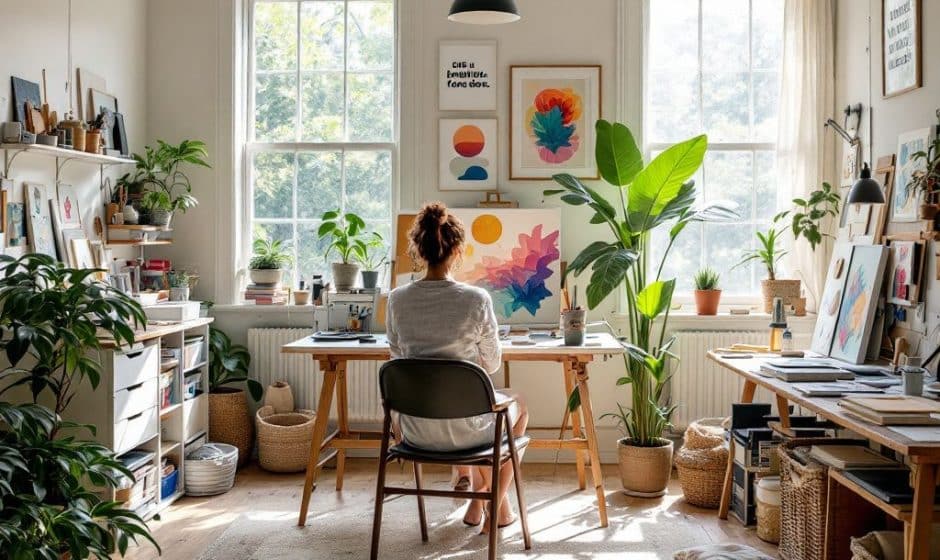Alright, let’s get real for a moment—managing an art studio balance can be tricky business, right? You have this amazing, inviting space that’s calling out for creativity. It might be bustling with paints, brushes, canvases with a sprinkle of inspirational clutter. But here’s the kicker: how do you maintain a creative haven without tripping over that magical mayhem? And that’s where our exploration begins.
Making Space for Creativity
Balance in an art studio doesn’t merely mean having all your tools in place but creating an environment that nurtures both creativity and your personal well-being. It’s about intertwining the necessity for order and the call to creativity. Trust me on this one, I’ve been through enough studio chaos to appreciate the subtle dance involved in bringing order from creative chaos.
First off, make sure you’ve carved out a specific space for different kinds of activities: a nook for sketching, a wall for mounting semi-finished pieces, and maybe a little Zen corner for those moments when you need to recharge. It’s all about designing your environment so that it energizes you—mentally and physically. This is where our secondary keyword, “studio wellness,” naturally slips in. Consider the physical health as a part of artistic health.
Determine What’s Essential
So, what precisely is essential in your creative workspace? Zero in on the tools you can’t live without—your favorite brushes, the go-to shades of paint, or the notebook that houses your ideas. These are your non-negotiables and deserve prime real estate in your studio. Everything else can gracefully step back. Too many unnecessary items can become distractions, cluttering not just the space, but your mind too!
Finding balance is also surprisingly linked with hormone regulation. Yeah, we’re gonna throw a little biology into the mix. Creating a well-organized, stress-free workspace can help regulate stress hormones like cortisol, putting you in a more relaxed, focused state of mind. That’s the weird, wonderful dance of art and science.
Lighting: More Than Just Illumination
Now, let’s shed some light—literally! Good lighting is to an artist what a perfectly seasoned dish is to a chef. Natural light is the jackpot if you can get it. However, if your studio doesn’t have windows (or if you’re a night owl creating under the moonlight), invest in full-spectrum bulbs that mimic natural daylight. They not only relieve eye strain but are also great for boosting your mood and supporting your studio wellness.
Ergonomic Ease + Studio Vibes

Alright, ergonomics might sound like a corporate buzzword, but don’t click away just yet. Picture this: You’re hunched over your easel, engrossed in work, and then, you feel it—a sharp nudge in the back of your neck. Ouch! Get that chair and table height right, and throw in a comfy standing mat if you work on foot. Your body will thank you by holding off on those annoying reminders that it needs some love too. Hormone regulation isn’t just about the brain – your body’s comfort plays a crucial role in overall well-being.
Declutter to Detangle
Now, let’s circle back to the clutter—not just the physical stuff, but the mental bits too. Every few months, take a hard look at your supplies and gently ask yourself, “Do I need this?” If it’s taking more space than it’s worth or hasn’t seen the light of day in ages, perhaps it’s time to donate, sell, or repurpose. Decluttering is, as you might guess, super effective for mental clarity. Less stuff equals more space in your brain for actual creative work.
Divide the Mess
Here’s a little illustrator’s secret: separate your projects into ‘done,’ ‘in progress,’ and ‘not yet started.’ Set aside individual trays or designated wall areas for each of these categories. This system helps prevent the emotional and physical jumble of unfinished business from overwhelming your work area. It’s like arranging your thoughts into tidy shelves—also a sneaky way of practicing some hormone regulation as you manage workflow stress.
Mindful Breaks Boost Creativity
When you’re lost in a project, hours can slip away without you noticing. Set an alarm if you need to, but make a habit of taking mindful breaks. Even five minutes of stretching, a brisk walk, or a quick cup of tea can recharge you mentally and physically. Bonus: regular breaks help balance those stress hormones, bringing your anxiety levels down and lifting your mood up. Art isn’t a race, after all—it’s a journey.
Making Time: The Most Crucial Balance
Balancing an art studio isn’t limited to tangible tidiness; time is your next biggest adversary and ally. Develop a routine that makes sense for you. Some find solace in morning light, others flex their creative muscle better at night.
Protect Your Time Blocks
Time blocking is a great technique to guard your creative hours. Picture this: slots of time—for brainstorming, actual creation, and let’s not forget cleanup—each deliberately scheduled. This practice not only preserves and protects creative hours but aids in emotional regulation too.
Wrapping your most intensive tasks around the times of day when you naturally have the most energy can lead to greater productivity and a smoother workflow. You’ll get more done and with less stress, giving you a hormone regulation boost by lowering strain triggers.

The Art of Saying No
Here’s another secret for maintaining your studio and time balance. It might sound cliché, but there’s magic in the word ‘no.’ Once you start respecting the time you have planned for art, naturally, other tasks will learn to wait their turn. That includes interruptions, favor requests, or procrastinations disguised as “urgent” diversions.
Tools and Technology: A Little Help Along the Way
Now, let’s have a little chit-chat about tech. It’s 2023, folks, and there’s an app for everything—including studio management! Tools such as Trello, Asana, or simple phone reminders can help keep your to-dos organized. And if digital isn’t your thing—classic planners or chalkboards work just as effectively.
Going Digital Without Ditching the Analog
Could be you’re digital. Could be you’re traditional. Or maybe you’re a delightful combination of both! Using digital tools to sketch out big plans provides the flexibility of editing and resizing without the mess. But when it’s time to get those personal touches just right, old-school pen and paper or brush and paint are unbeatable.
It’s about achieving a balance between the digital and the tangible worlds, embracing the benefits of each. So, perhaps you consult a digital mood board for inspiration and stick to pencil sketching once your muse has spoken—or vice versa.
Creating a Studio Sanctuary: A Personal Touch
Spin that balance with a personal flair. A studio isn’t just a production space; it’s a sanctuary. Maybe you drape fairy lights or include a plant or two—they’re lovely for air quality and hormone regulation, believe it or not! Infusing personal touches isn’t merely for aesthetics. It’s about making your studio feel welcoming, sparking joy and tranquility, and encouraging you to keep churning out your masterpieces.
Soundtrack for Inspiration
A few melodic waves or ambient beats might just be the muse missing from your studio’s aura. Think of it like seasoning—every creation has its own flavor of inspiration, right? You might go for nature sounds, smooth jazz, or even your favorite playlist. Finding the right balance for you, and bringing hormonal harmony, rarely comes with complete silence.
Common Mistakes and How to Dodge Them

We’ve been chatting a while, feeding off each other’s nuggets of wisdom. But no good conversation avoids what not to do. So, let’s delve into a few common mistakes and approaches to avoid them—certainly with humor on our side.
Overstuffing the Studio
Guilty! It’s an easy trap—overloading space with every instrument, color, and medium under the sun. Resisting the urge to collect is a challenge, but focusing instead on the quality and essentials leads to powerful simplicity. Less routine hunting, more creating!
Forgetting About Sustainability
Yep, all that clutter has another side effect—it isn’t great for the planet. Making conscious decisions about materials, trying eco-friendly products, and responsibly discarding waste reinforce sustainability which, in turn, reflects in your art. That in itself brings balance to mind, space, and creativity.
Neglecting Self
How about we all agree—taking care of oneself isn’t self-indulgence? It’s self-preservation. Skipping meals, ignoring hydration, or depriving sleep reflects directly on creative output and stability. Balance better by fueling creatively and emotionally. Heroic artists still need nutritious fuel to support their craft.
Putting It All Together: Your Ideal Art Studio Balance
Here we are—full circle in our exploration of achieving the perfect balance in our creative sanctuaries. Remember, an art studio isn’t just a room with walls and paint—it’s where ideas meet reality, the subconscious chats with daylight, and where you harmonize sights, smells, and sounds into art worth creating.
After wading through the intricacies of organization, intentional time management, self-care, and personal touches, and not forgetting hormonal wellness—it’s down to experimentation with these guidelines, figuring out what truly works for your creative flourish.
Your art space doesn’t need to be perfectly curated—it’s supposed to see a mess here and there (think of it as personality). But by making smaller adjustments with thought and care, you’ll find peace in the chaos, a sparkle in every deliberate choice, and perhaps even a new wave of inspiration. Keep revisiting these themes when the balance feels off, allowing the rhythm of studio and creativity to play in harmony.
Happy creating, and may your studio forever brim with warm light and joyful creativity!
Frequently Asked Questions
What causes a hormonal imbalance?
A hormonal imbalance can be caused by natural changes or stages in life, such as puberty, pregnancy, perimenopause, and menopause. Other factors include genetics, aging, increased daily stress, poor nutrition, lack of proper activity and fitness, and certain medical conditions like tumors, adenomas, or autoimmune diseases[3][5].
What are the signs and symptoms of a hormonal imbalance?
Signs and symptoms of a hormonal imbalance can include irritability and fatigue, mood swings and depression, skin dryness and loss of elasticity, water retention and weight gain, osteoporosis and joint pain, decreased libido, insomnia and other sleep disorders, and memory issues. These symptoms can vary depending on which hormone is imbalanced[3][5].
How does hormone replacement therapy help with hormonal imbalances?
Hormone replacement therapy (HRT) helps by restoring hormones to stable levels, which can improve sleep, increase energy, enhance memory, improve mood stability, and increase interest in sex. It can also help with weight regulation, reduce water retention, and protect joints and bones. Bio-identical hormone replacement therapy (BHRT) is a type of HRT that uses hormones identical in structure to those produced by the human body[1][3].
Who can benefit from bioidentical hormone replacement therapy (BHRT)?
BHRT can be beneficial for women in perimenopause and menopause experiencing symptoms like night sweats, memory loss, weight gain, hot flashes, and low libido. It can also help men experiencing symptoms of andropause such as weight gain, fatigue, stress, loss of libido, energy issues, and decreased muscle mass[1].
References




